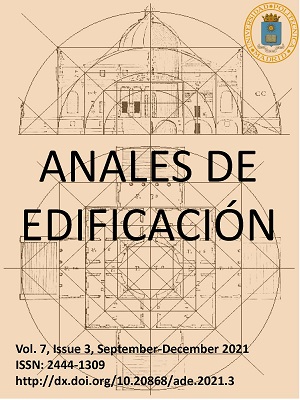Caracterización constructiva y estado de conservación de la arquitectura del agua en el Valle de Lecrin (Granada, España) = Constructive characterization and state of conservation of water architecture in the Lecrin Valley (Granada, Spain).
DOI:
https://doi.org/10.20868/ade.2021.4972Keywords:
Arquitecturas del agua, patrimonio hidráulico, estudio matérico, estudio lesivo, water architectures, hydraulic heritage, material study, damage studyAbstract
El Valle de Lecrín, comarca granadina situada en la vertiente suroccidental de Sierra Nevada, reconoce el agua como recurso fundamental para su desarrollo tecnológico y social, siendo también responsable de la evolución del paisaje y sus poblaciones. Las arquitecturas hidráulicas, que tienen o han tenido relación con el agua ya sea con el fin de distribuirla, conducirla, almacenarla o utilizarla como fuerza motriz industrial, constituyen el principal objetivo del estudio llevado a cabo, en un total de 72 arquitecturas, centrado en determinar su localización, reconocimiento tipológico y conservativo. Por otro lado la clasificación de las arquitecturas en distintos grupos de estudio permite conocer como principales resultados la incidencia que cada uno de ellos supone en el estado de conservación así como otras cualidades específicas. Las conclusiones obtenidas establecen relaciones entre la tipología arquitectónica, la protección legal, el uso y las técnicas constructivas, reconociendo un deterioro avanzado en un gran número de elementos incluso algunos en grave peligro de desaparición.
Abstract
The Lecrín Valley, a region of Granada located on the southwestern slope of Sierra Nevada. This territory recognizes water as a fundamental resource for its technological and social development, being also responsible for the evolution of the landscape and its population. Hydraulic architectures, understood as those constructions that are or have been related to water, either for the purpose of distributing, conducting, storing or using it as an industrial driving force, constitute the main objective of this study. From a total of 72 architectures, attention is focused on determining their location, architectural typology and conservation state. On the other hand, the classification of architectures in different study groups: defensive architectures, mills and other architectures, allows to know as main results the incidence that each of the groups has in the state of conservation as well as other specific qualities. The conclusions obtained through this comparative study have allowed to establish relationships between the architectural typology, legal protection, use and construction techniques, recognizing advanced deterioration in a large number of elements, including some in serious danger of disappearance.
Downloads
References
J.Beas Torroba. (Coord.) (1990). Atlas hidrogeológico de laprovincia de Granada. Granada: Diputación Provincial deGranada e Instituto Tecnológico Geominero de España
I.Bestué Cardiel & I. González Tascón. (Coords.) (2006).Breve guía del patrimonio hidráulico de Andalucía. Sevilla:Agencia andaluza del agua, Consejería de Medio Ambiente,Junta de Andalucía
J.F. García Pérez. (2015). Paisajes históricos del área Norte del Valle de Lecrín: de la época nazarí a la conquista castellana (Tesis Doctoral). Granada: Universidad de Granada.
J.R. Guzmán Álvarez. (2014). La lógica de los sistemas hidráulicos del Valle de Lecrín y su justificación histórica y territorial: el caso de las acequias de Cozvíjar, Dúrcal y Nigüelas. En Sanchis-Ibor, C., Palau-Salvador, G. Mangue Alférez, I. Martínez-Sanmartín, L. P. (Eds.), Irrigation, Society, Landscape. Tribute to Thomas F. Glick (pp. 91-106). Valencia: Universitat Politècnica de València
M.A. Molina Fajardo. (2006). Revisión bibliográfica para elestudio del patrimonio histórico artístico en el Valle deLecrín (Granada) siglos XIII a XVII. Granada: Universidadde Granada
M.A. Molina Fajardo. (2013). Readaptación doméstica deciertas estructuras defensivas tras la expulsión de losmoriscos: las torres de alquería del Valle de Lecrín(Granada). En Actas del XII Simposio Internacional deMudejarismo (pp. 645-654). Teruel: Centro de EstudiosMudéjares
L.L. Padilla Mellado & M. Espinar Moreno. (2007).Arquitectura defensiva del Valle de Lecrín. Granada: ASB Producciones Editoriales
J.M. Reyes Mesa. (2006). Los molinos hidráulicos harineros dela provincia de Granada. Granada: Editorial Axares
F.Villegas Molina. (1972). El Valle de Lecrín. EstudioGeográfico. Granada: Instituto de Geografía Aplicada delPatronato “Alonso Herrera”- Consejo Superior deInvestigaciones Científicas
Downloads
Published
Issue
Section
License
Anales de Edificación does not charge authors for processing or publishing an article and provides immediate Open Access to its content. All content is available free of charge to the user or his institution. Users are permitted to read, download, copy, distribute, print, search or link to the full text of articles, or use them for any other lawful purpose, without prior permission from the publisher or author. This is in accordance with the BOAI definition of open access.
- Authors retain the copyright and grant to the journal the right to a Creative Commons attribution / Non-Commercial / Non-Derivative 4.0 International (CC BY NC ND) License that allows others to share the work with an acknowledgement of authorship and non-commercial use.
- Authors may separately establish additional agreements for the non-exclusive distribution of the version of the work published in the journal (for example, placing it in an institutional repository or publishing it in a book).
Unless otherwise indicated, all contents of the electronic edition are distributed under a Creative Commons license.












